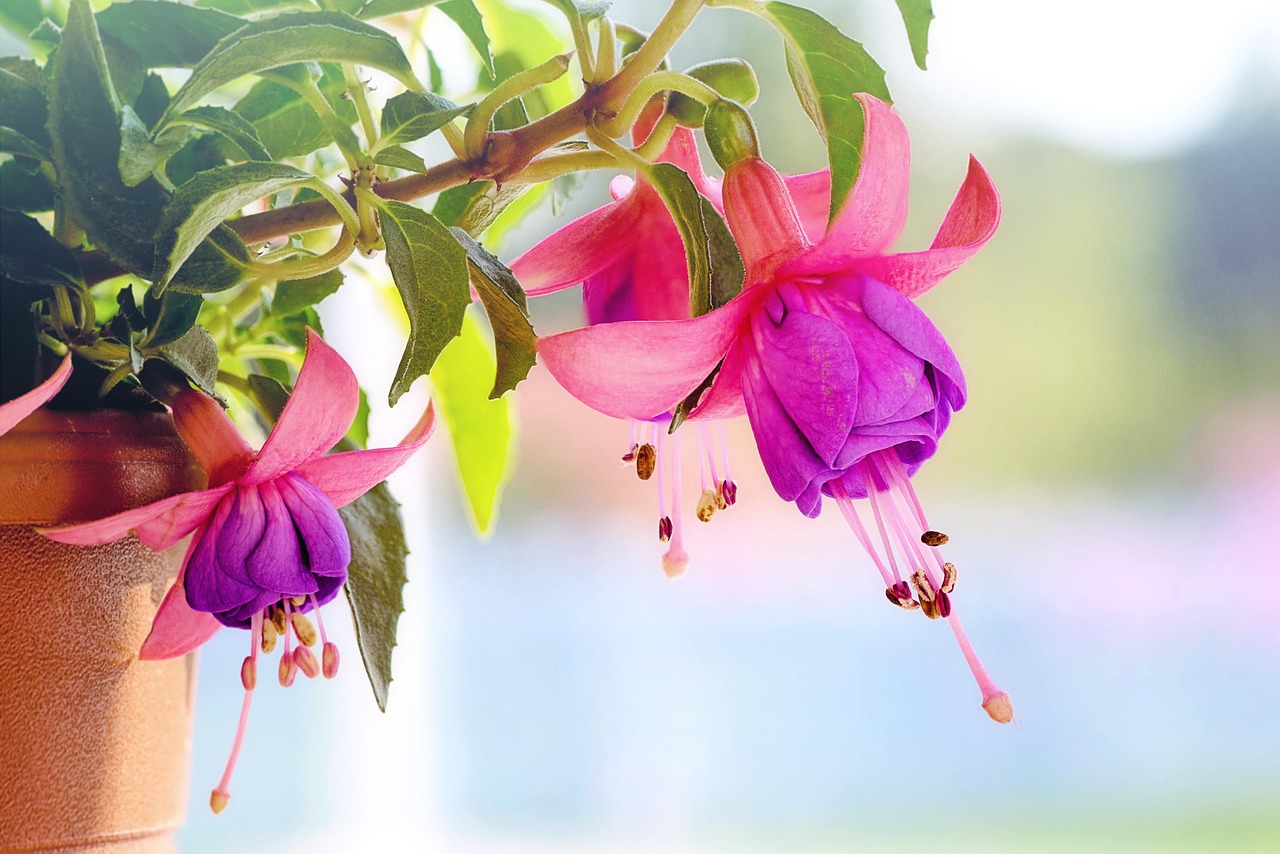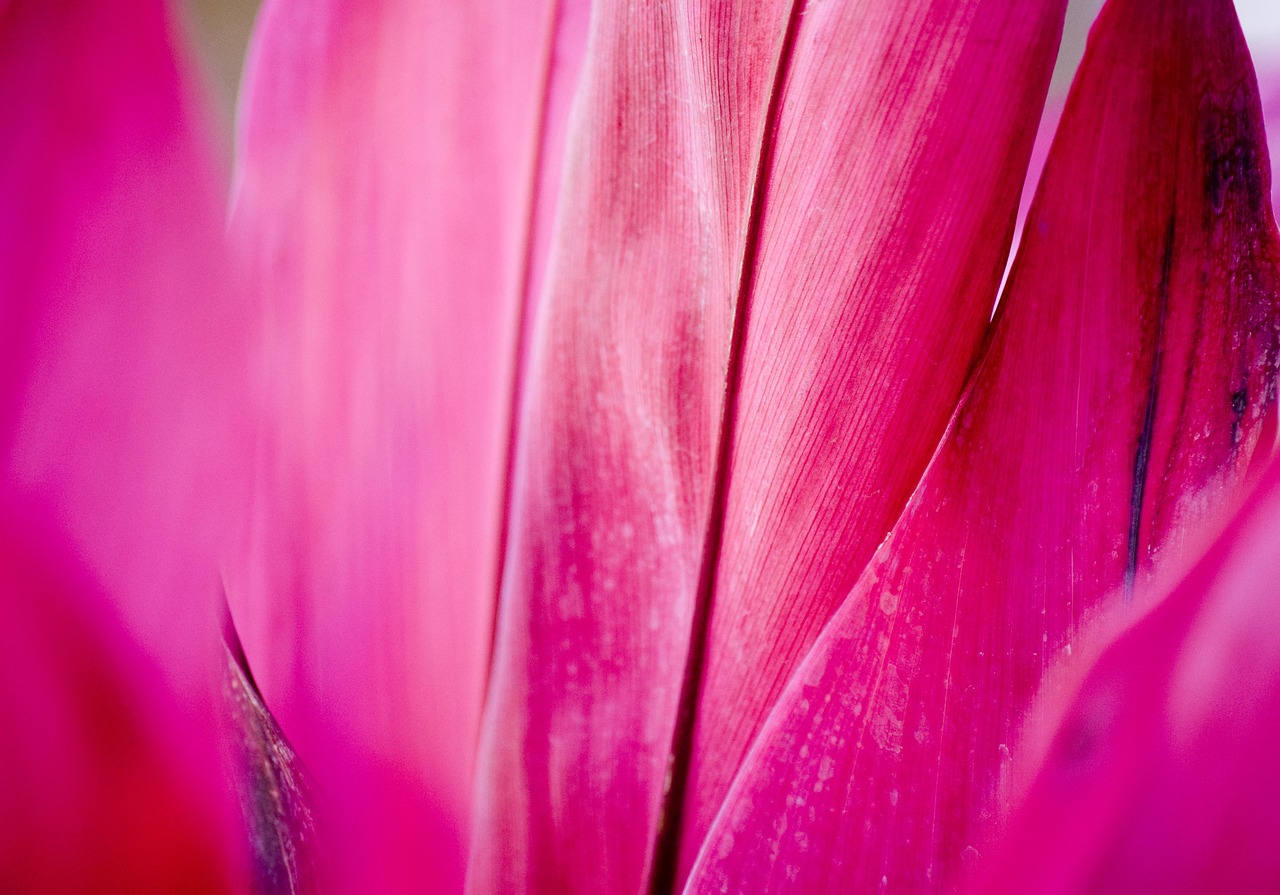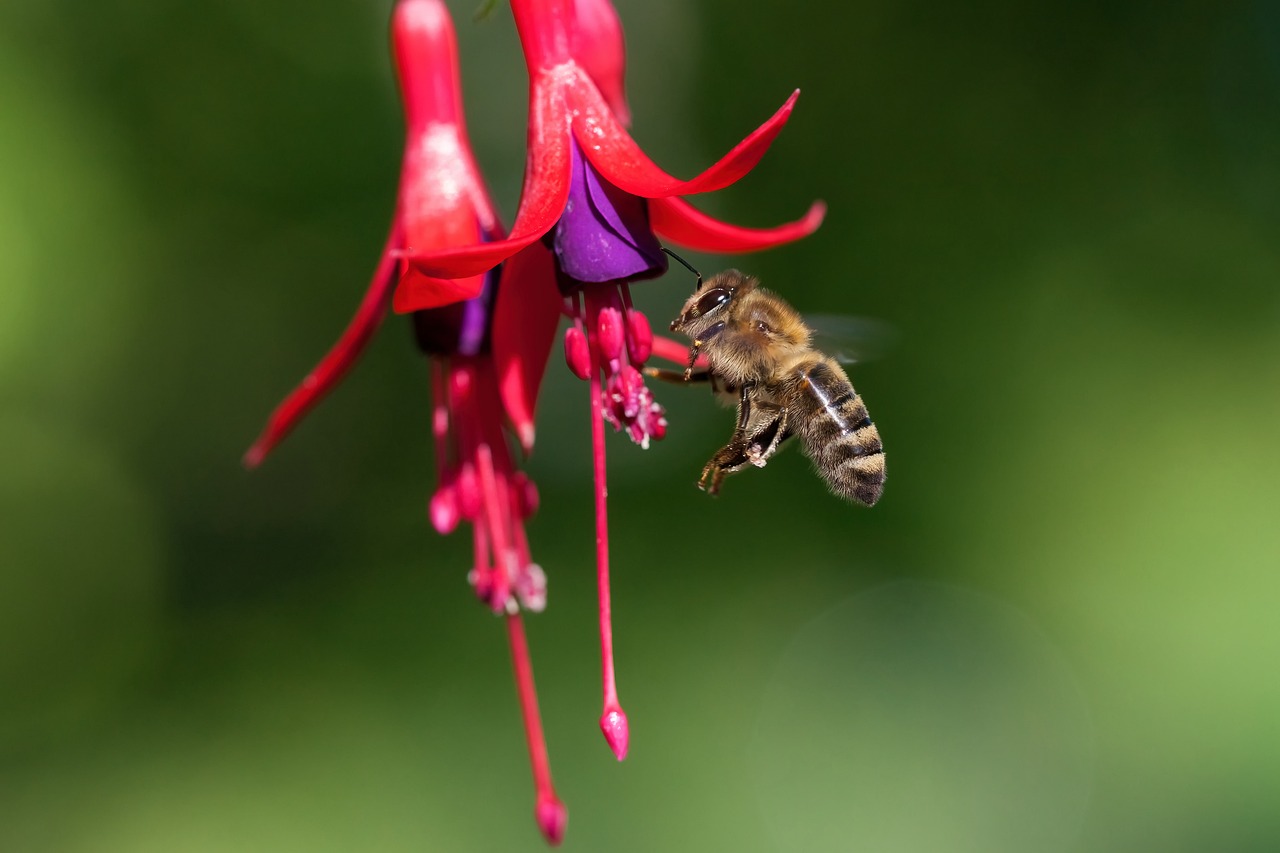To grow and care for fuchsia flowers, provide them with well-drained soil, partial shade, and regular watering. Fertilize them monthly during the growing season and prune them after flowering to encourage new growth. Protect them from frost to ensure a healthy and vibrant display.
Fuchsia flowers are beloved for their stunning, pendulous blooms and vibrant colors. These plants are native to Central and South America, as well as New Zealand. Fuchsias are often used in hanging baskets, containers, and garden beds, making them versatile choices for gardeners. With their unique teardrop shape, fuchsia blooms attract pollinators like bees and hummingbirds, adding life to any outdoor space.

Growing fuchsias can be a rewarding experience for both novice and experienced gardeners. They thrive in cooler temperatures, making them ideal for spring and summer gardens. Understanding their specific needs will help you create a flourishing environment for these beautiful flowers.
Understanding Fuchsia Varieties
Fuchsias come in many varieties, each with its unique characteristics. Knowing the different types can help you select the best one for your garden or home. Below is a table outlining some common fuchsia varieties along with their key features:
| Variety | Flower Color | Growth Habit | Best Use |
|---|---|---|---|
| Fuchsia magellanica | Pink and purple | Shrub | Garden borders |
| Fuchsia triphylla | Orange and red | Trailing | Hanging baskets |
| Fuchsia x hybrida | Various colors | Bushy | Pots and containers |
| Fuchsia ‘Dollar Princess’ | Pink and white | Mounding | Window boxes |
In addition to their aesthetic appeal, fuchsias can be appreciated for their ability to adapt to different growing conditions. They flourish in partial shade but can also tolerate full sun if given enough water. However, direct sunlight for prolonged periods may lead to scorched leaves.

Choosing the Right Location
Selecting the right location for fuchsias is crucial for their growth. These plants prefer areas with bright, indirect sunlight. A spot that receives morning sun and afternoon shade is ideal. If planting outdoors, consider the following:
- Choose a location protected from strong winds to prevent damage to delicate blooms.
- Avoid areas with extreme heat or direct sunlight for extended periods.
- If growing indoors, place them near a window with filtered light.
Soil quality is equally important when cultivating fuchsias. They prefer well-draining soil rich in organic matter. A mix of potting soil and compost works well for container gardening. For garden beds, you can amend the soil with peat moss or well-rotted manure to provide adequate nutrients.
Watering and Fertilizing Fuchsias
Fuchsias require consistent moisture but do not like to sit in waterlogged soil. It’s important to strike a balance when watering. The following tips can help ensure your fuchsias stay hydrated:

- Water when the top inch of soil feels dry to the touch.
- Avoid overhead watering to prevent fungal diseases.
- If grown in containers, ensure pots have drainage holes to release excess water.
During the growing season, typically from spring to early fall, fuchsias benefit from regular fertilization. Using a balanced liquid fertilizer every four weeks will promote healthy growth and vibrant blooms. Always follow the manufacturer’s instructions for the correct dilution and application method.
Caring for fuchsias throughout the growing season will reward you with lush foliage and spectacular flowers. Regular maintenance, including deadheading spent blooms and pruning at the right times, will encourage continuous blooming and keep your plants healthy.
Pruning and Deadheading Fuchsia Flowers
Pruning and deadheading are essential practices for maintaining the health and beauty of fuchsia plants. These actions help promote new growth, encourage more blooms, and keep the plants looking tidy. Understanding when and how to prune fuchsias can significantly enhance their performance.

Deadheading Fuchsias
Deadheading involves removing spent flowers from the plant. This process not only improves the plant’s appearance but also encourages it to produce more blooms. Here are some tips for effective deadheading:
- Use sharp, clean scissors or pruning shears to avoid damaging the plant.
- Remove the entire flower stem just above the first set of leaves.
- Perform deadheading regularly, ideally every week during the peak blooming season.
In addition to enhancing aesthetics, deadheading can prevent plants from diverting energy into seed production. Instead, this energy is redirected towards producing new flowers.
Pruning Techniques
Pruning fuchsias is necessary for maintaining their shape and health. It is best done after the flowering period, usually in late summer or early fall. Here are some key points to consider when pruning your fuchsia plants:
- Remove any dead or damaged stems to encourage healthy growth.
- Cut back leggy growth to promote bushier plants.
- Shape the plant by trimming back overgrown areas.
For winter protection, many gardeners choose to prune fuchsias back to about one-third of their height. This helps the plant conserve energy during dormancy. In colder climates, consider bringing potted fuchsias indoors during winter to protect them from frost.
Propagation of Fuchsia Plants
Propagating fuchsia plants is a rewarding way to expand your garden. There are several methods to propagate fuchsias, including cuttings and seed sowing. Here, we will focus on the cutting method, as it is the most common and effective.
Taking Cuttings
The best time to take cuttings is during the growing season, ideally in early summer. Here’s a step-by-step guide on how to do it:
- Select a healthy stem that is at least 4 inches long and has several leaves.
- Using clean scissors, cut below a node (the point where leaves meet the stem).
- Remove the lower leaves, leaving only two or three sets of leaves at the top.
- Dip the cut end in rooting hormone to encourage root development (optional).
- Plant the cutting in a pot filled with a well-draining potting mix.
- Water gently and cover with a plastic bag or plastic dome to create humidity.
- Place in a warm area with indirect light and check regularly for moisture.
After a few weeks, the cutting should develop roots. You can check for root development by gently tugging on the cutting; resistance indicates roots have formed. Once rooted, transplant your new fuchsia into a larger container or directly into your garden.
Pest and Disease Management
Fuchsias are generally resilient plants, but they can be susceptible to pests and diseases if not properly cared for. Being proactive can help prevent infestations and infections.
Common Pests
The following pests are known to affect fuchsia plants:
- Aphids: These small insects suck sap from the plant, leading to wilting and yellowing leaves.
- Spider mites: These pests thrive in dry conditions and can cause leaf discoloration and webbing on the foliage.
- Whiteflies: Like aphids, whiteflies feed on plant sap and can weaken the plant significantly.
If you notice any signs of pests, act quickly. You can wash them off with a strong stream of water or apply insecticidal soap as per package instructions.
Diseases
Fuchsia plants can also suffer from certain diseases such as:
- Powdery mildew: A fungal disease that appears as white powdery spots on leaves. Improve air circulation and avoid overhead watering to prevent this issue.
- Root rot: Caused by overwatering or poor drainage, root rot can lead to wilting and yellowing leaves. Ensure proper watering practices to avoid this problem.
Regularly inspecting your plants for signs of pests or diseases will help you manage any issues before they become severe. Maintaining good cultural practices is key to keeping your fuchsias healthy and thriving.
Seasonal Care for Fuchsia Plants
Caring for fuchsia plants varies with the seasons. Each season presents unique challenges and opportunities for growth, making it essential to adjust your care routine accordingly. Below is a breakdown of how to care for fuchsias in spring, summer, fall, and winter.
Spring Care
Spring is the time when fuchsias awaken from their winter dormancy. As temperatures rise, it is important to prepare your plants for the growing season:
- Repotting: If your fuchsias are in containers, consider repotting them in fresh potting soil. This provides new nutrients and encourages healthy growth.
- Fertilization: Begin fertilizing with a balanced liquid fertilizer every four weeks to boost growth. This will help your plants produce lush foliage and abundant blooms.
- Pruning: Prune back any dead or damaged stems to encourage new growth. This is also a good time to shape the plant.
Monitor the weather closely during spring. Protect your fuchsias from late frosts by covering them or bringing potted plants indoors if necessary.
Summer Care
During the summer months, fuchsias thrive with proper care. Here are some tips for keeping them healthy:
- Watering: Maintain consistent moisture in the soil. Water deeply when the top inch is dry to prevent stress during hot periods.
- Deadheading: Continue to deadhead regularly to promote new blooms and keep the plant looking tidy.
- Pest Management: Regularly check for pests such as aphids and spider mites, especially in hot and dry conditions.
Consider providing shade during extreme heat, as excessive sun exposure can scorch leaves and affect flowering.
Fall Care
As temperatures begin to drop in fall, it is time to prepare your fuchsias for winter. Here’s how:
- Reduce Fertilization: Cut back on fertilizing as the plants begin to slow down and prepare for dormancy.
- Pruning: After the last blooms fade, prune back leggy growth and remove any dead or diseased branches.
- Transitioning Indoors: If you live in colder climates, start moving your potted fuchsias indoors before the first frost. Ensure they have adequate light and humidity indoors.
This transition helps prevent shock and allows the plants to acclimate to indoor conditions gradually.
Winter Care
Winter can be a challenging time for fuchsia plants, especially those grown outdoors. Caring for them properly during this season is crucial:
- Indoor Care: Keep indoor fuchsias in a bright location with indirect sunlight. Water sparingly, allowing the soil to dry out slightly between waterings.
- Temperature Control: Maintain a stable temperature between 60°F to 70°F (15°C to 21°C) to keep your plants comfortable.
- Humidity Management: Fuchsias appreciate humidity. Consider using a humidifier or placing trays of water near the plants to increase moisture levels.
If you have outdoor fuchsias, protect them by mulching around the base or covering them with frost cloths during particularly cold nights. In very cold climates, it may be best to bring them indoors altogether.
Troubleshooting Common Issues
Even with careful attention, you may encounter issues with your fuchsia plants. Here are some common problems and how to address them:
Leaf Drop
If your fuchsia is dropping leaves, it could be due to several factors:
- Underwatering: Ensure that you are providing adequate moisture without letting the soil dry out completely.
- Overwatering: Check for signs of root rot, which can occur if the plant is sitting in waterlogged soil.
- Pest Infestation: Inspect for pests that may be causing stress to the plant.
Poor Blooming
If your fuchsia isn’t blooming well, consider these factors:
- Lack of Sunlight: Ensure that your plants are receiving enough indirect sunlight.
- Nutrient Deficiency: Regular fertilization during the growing season is key for abundant blooms.
- Pest Problems: Check for pests that might hinder flowering.
Troubleshooting these common issues early can help ensure that your fuchsia flowers thrive throughout the growing season and beyond.
Advanced Techniques for Fuchsia Care
For those looking to take their fuchsia gardening to the next level, there are several advanced techniques that can enhance growth, flowering, and overall plant health. These methods require a bit more knowledge and care but can yield impressive results.
Using Companion Plants
Companion planting can benefit fuchsia plants by promoting healthier growth and reducing pest issues. Here are some beneficial companion plants:
- Marigolds: These flowers can deter aphids and other pests that may affect fuchsias.
- Basil: Not only does basil provide culinary benefits, but it also repels certain pests.
- Nasturtiums: These plants can attract beneficial insects that prey on harmful pests.
When planting companion plants, ensure they have similar light and water requirements to fuchsias to create a harmonious garden environment.
Creating a Microclimate
A microclimate is a localized climate that differs from the surrounding area. You can create a beneficial microclimate for your fuchsias by using the following techniques:
- Grouping Plants: Plant fuchsias alongside other plants that provide shade or moisture retention. This can help regulate temperature and humidity.
- Using Mulch: Applying mulch around the base of your plants helps retain soil moisture and regulates temperature extremes.
- Windbreaks: Utilize fences or taller plants to shield your fuchsias from harsh winds, which can dry them out and damage foliage.
By creating a microclimate, you can enhance the growing conditions for your fuchsias, promoting healthier and more vigorous plants.
Seasonal Container Change
If you are growing fuchsias in containers, consider rotating their position with the seasons. During cooler months, move them to more sheltered areas to protect them from frost. In summer, reposition them to take advantage of dappled sunlight while avoiding harsh afternoon rays.
Choosing the right pot is also essential. Ensure your containers have adequate drainage holes to prevent waterlogging. Terra cotta pots, for instance, are great for their breathability but may require more frequent watering compared to plastic pots.
Final Thoughts
Caring for fuchsia flowers can be a delightful experience for any gardener. With their vibrant colors and unique shapes, these plants add beauty and charm to any landscape or indoor space. Remember that successful fuchsia cultivation begins with choosing the right variety and providing optimal growing conditions.
Maintaining proper watering practices, providing adequate light, and managing pests and diseases are all critical components of fuchsia care. Regular deadheading and pruning not only enhance the appearance of your plants but also encourage new blooms throughout the season.
By employing advanced techniques such as companion planting and creating a microclimate, you can elevate your gardening skills and improve the health of your fuchsias. With patience and care, you will enjoy spectacular blooms that attract pollinators and bring joy throughout the growing season.
Whether you are a novice gardener or an experienced horticulturist, understanding the specific needs of fuchsias will lead to a flourishing garden filled with these lovely flowers. Embrace the journey of gardening with fuchsias, and let their beauty inspire you each season.
